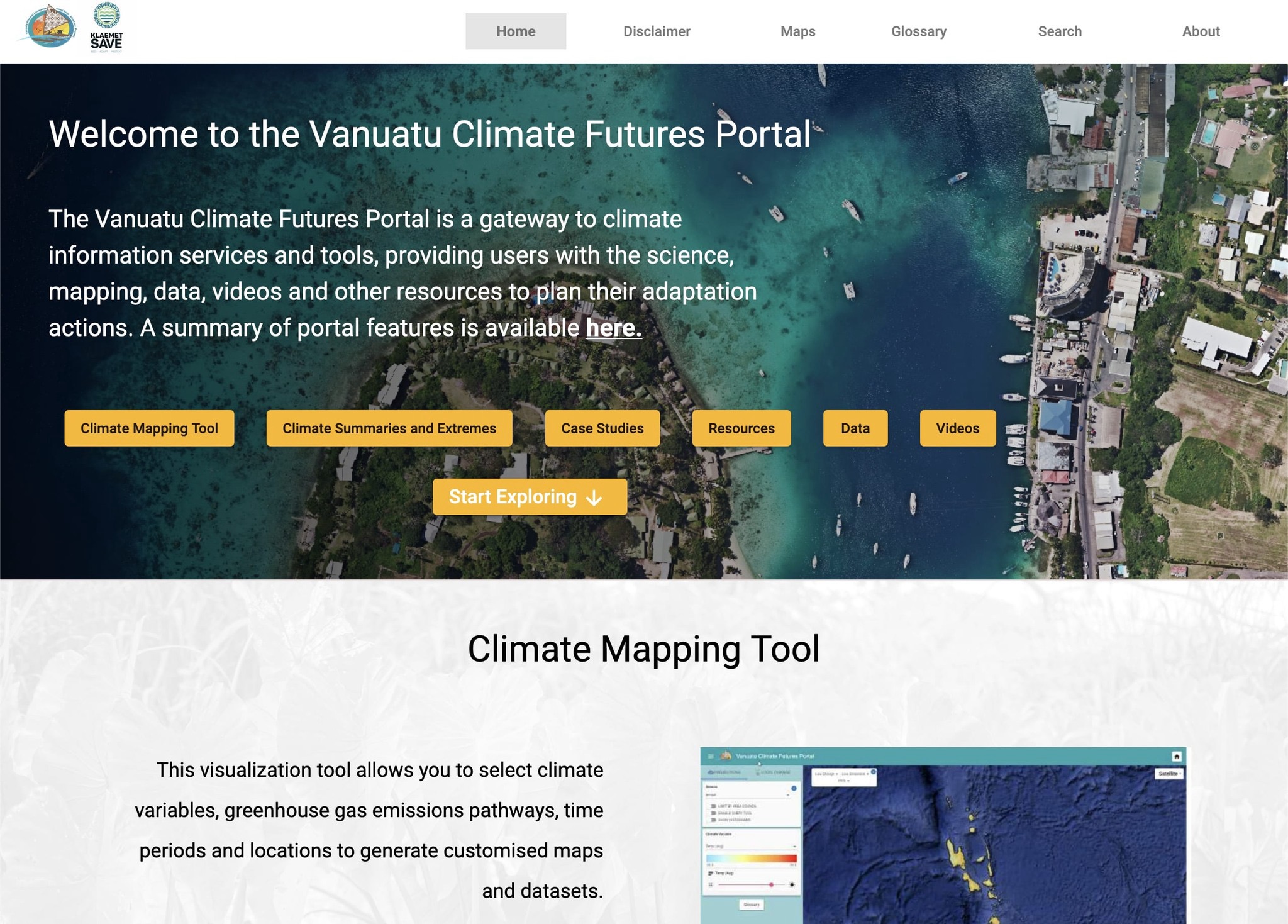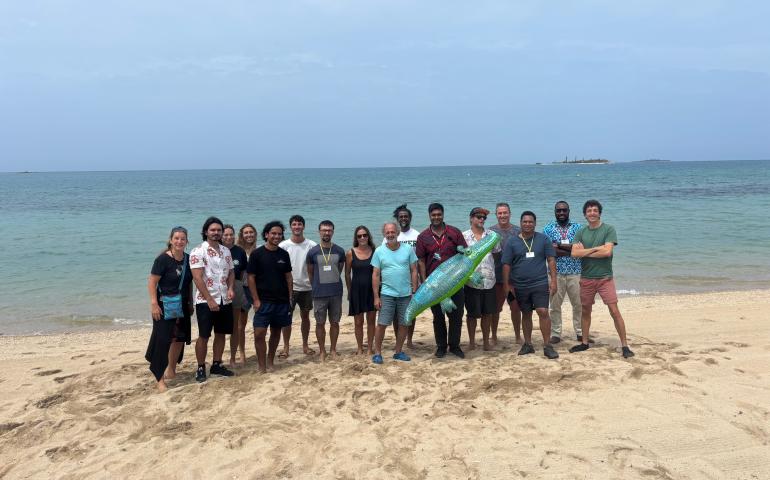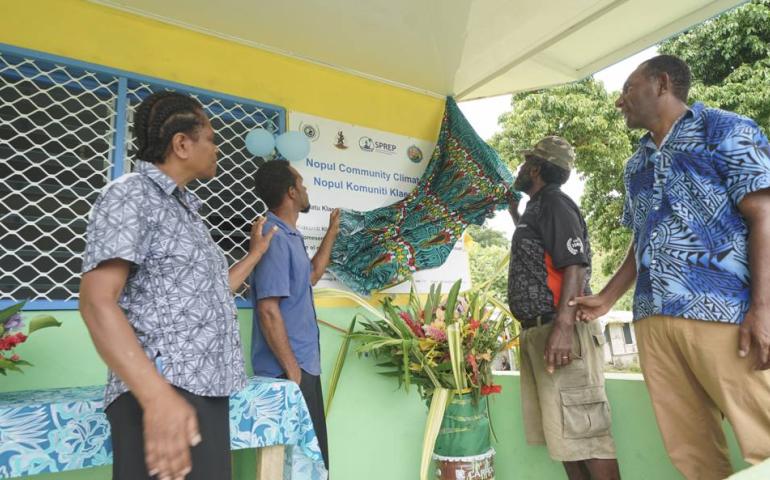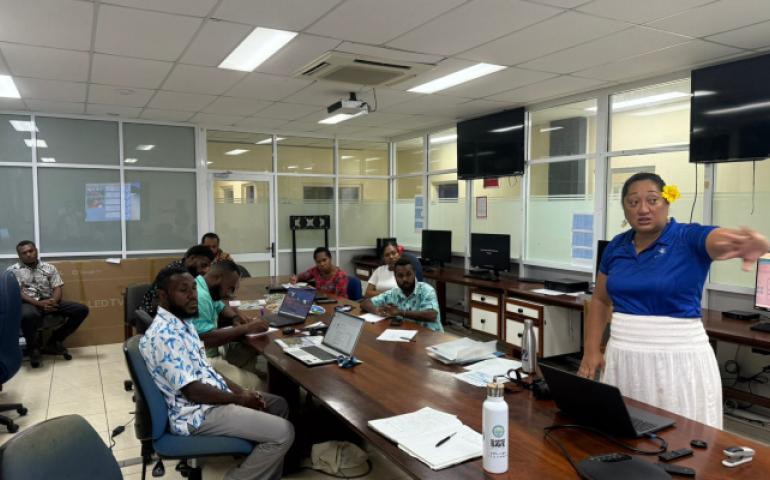New Vanuatu Climate Futures portal website a leap forward for national climate change adaptation
17 November 2023, Port Vila, Vanuatu - Vanuatu’s climate is changing rapidly because of human-induced climate change. The country is already being hit by rising sea levels, stronger cyclones, marine heatwaves and extreme rainfall, and more change is projected to impact Vanuatu in the future.
Like every country on Earth, Vanuatu is in the midst of a climate emergency that affects every part of the country, and every sector of the economy, right down to the community level.
To help the country adapt to the changing climate, high-quality information is needed to ensure that the nation is ready for a changing climate, and has the adaptive capacity needed to protect people, communities and productive sectors.
In a first for the Pacific Islands region, a new climate information portal from the Climate Information Services for Resilient Development Planning in Vanuatu Project (known locally by its Bislama acronym, VanKIRAP) has been developed to deliver exactly this kind of high-quality climate information for Vanuatu.
The Vanuatu Climate Futures Portal provides an array of climate information across multiple timescales, from current climate, to Vanuatu’s projected future climate in the decades to come. This is important, as many changes that are predicted for the climate are expected to take decades to occur.
The portal has been co-designed through a collaboration with the Vanuatu Government, the VanKIRAP Project’s managing entity, the Secretariat of the Pacific Regional Environment Programme (SPREP) and the Australian Government’s national science agency, the Commonwealth Scientific and Industrial Research Organisation (CSIRO).
The portal website is online now at https://vanclimatefutures.gov.vu, hosted by the Vanuatu Meteorology and Geohazards Department (VMGD). It offers several features that deliver different kinds of climate information tailored to meet the requirements of different categories of end users.

The website’s climate mapping tool allows users to select climate variables (e.g. temperature), greenhouse gas emissions scenarios (e.g. low/high), future time periods (e.g. 2050), and locations (e.g. local area council) to generate and download customised maps and data sets. Users can zoom in and out, display maps side-by-side for comparison, and display averages by year, season or month.
Fact sheets on climate extremes provide information about extreme rainfall, tropical cyclones, coastal inundation, marine heatwaves, drought, and ocean acidification. Climate summaries describe projected changes for the northern, central and southern subregions of Vanuatu.
Case studies for the key infrastructure, water, agriculture, fisheries, and tourism sectors give examples of how climate information can be used in impact assessments in each sector. Each of the 15 case studies follows an 8-step impact assessment process.
Other resources on the website include explainers and reports that provide more technical information about specific topics like greenhouse gas emissions, climate variability and climate projections.
Access to the data and graphs displayed on the portal, along with relevant metadata and quality assurance information, is also available. A set of videos are also accessible via the portal, including videos on impact assessment, sectoral impacts of climate change, regional climate summaries, and guides on how to use the portal.
Officially launching the Vanuatu Climate Futures portal on 17 November at the Ramada Resort in Port Vila, Vanuatu’s Minister for Climate Change Hon. Ralph Regenvanu MP spoke of the challenges that Vanuatu is facing from climate change: “We all know that climate change impacts are becoming more and more serious for Vanuatu. As we've recognised, it's the major security threat going forward for all our communities. The biggest challenge for us now is keeping everybody safe.”
“More and more people in Vanuatu are becoming unsafe because of the impacts of sea level rise, catastrophic events which are increasing in frequency and intensity. We have to be ready to respond. We have to receive good warnings. We have to be able to look out into the future. We have to live in places that we know are going to be safe. We have to build resilient infrastructure, resilient infrastructure including public infrastructure, schools, evacuation centres, hospitals, and health centres”, the Minister said in his speech.
“One of the most important jobs of the government, including mainly through the VMGD and VanKIRAP Project, is to help us make informed decisions about how we're going to make people safer in the future. This Vanuatu Climate Futures Portal is a great tool to assist us to do this”, he added.
Australia’s High Commissioner to Vanuatu, Her Excellency Heidi Bootle, gave the Australian Government’s perspective on the importance of the portal: “This new climate information service product that will support our efforts to help reduce impacts of climate change and ensure people's livelihoods are resilient. This portal is a response to Vanuatu's National Sustainable Development Plan for improved monitoring and early warning systems that will strengthen resilience to climate and disaster risks.”
High Commissioner Bootle identified that a key strength of the portal “is the climate change science information that can be retrieved from the portal to plan the sectoral and community development. It can also support the government's risk assessments and plan adaptation across all sectors and provinces of Vanuatu”, she noted.
Geoff Gooley, CSIRO’s project lead on the Vanuatu Climate Futures portal, emphasised how the collaborative co-production of the portal is central to its success. He listed the partners involved, who included CSIRO, the Vanuatu government through VMGD and key sectors, SPREP, the APCC Climate Centre in South Korea, and Australia’s Bureau of Meteorology.
“The strength of this partnership is apparent because you cannot undertake a co-designed, co-produced project of this scale and this complexity without those trusted partnerships”, he said.
Gooley detailed how that starting point for the portal was the declaration of the Paris Agreement in December 2015, eight years ago. The portal is aligned with the target of limiting global temperatures to 1.5°C above pre-industrial levels, and incorporates the high and low emissions scenarios set at the Paris COP. These can be used in the portal to model how Vanuatu’s climate is likely to be affected by changes to the climate in coming decades.
What makes the portal different to previous tools, he says, is how it contains climate projections tailored to Vanuatu’s priority sectors: water resources, agriculture, fisheries, tourism, and infrastructure.
“We’ve applied climate information in the portal to demonstrate the application at a practical level with our sectoral partners”, said Gooley at the launch. “For each of those sectors, we set about taking the science-based climate information service products, working with our sector coordinators, and applying them in a practical way”, he said.
The science behind the portal is significant, says Gooley. “The portal contains first-ever high resolution, fine scale, cutting-edge climate hazard modelling and assessments to look at particularly extreme sea levels in Vanuatu, which are driving coastal inundation risks and impacts on coastal communities, and coastal infrastructure. Likewise, we also extended out into the coastal zone, new information around things like marine heat waves and ocean acidification, which are some of the critical parameters that are driving climate change” in Vanuatu, he said.
Director of VMGD, Montine Romone, also speaking at the launch, stressed how the Vanuatu Climate Futures portal’s science-based climate information will benefit all communities in Vanuatu: “I believe that the portal is something that will help us to equip our people with early warning information about climate change that uses the latest scientific knowledge about Vanuatu’s climate that is available to us today”, he said.
The Vanuatu Klaement Infomesen blong Redy, Adapt mo Protekt (Van-KIRAP) project is a five-year, USD 22 million project which aims to support climate resilient development in Vanuatu through the development, communication, and application of climate information services to benefit agriculture, fisheries, tourism, infrastructure, water sectors and communities. It is funded by the Green Climate Fund and implemented by the Secretariat of the Pacific Regional Environment Programme in partnership with the Vanuatu Meteorology and Geo-hazards Department, Commonwealth Scientific and Industrial Research Organisation, Australian Bureau of Meteorology, and APEC Climate Center.
For more information, please contact Mr. Sunny Kamuta Seuseu, Acting Manager, Climate Information Services for Resilient Development Planning in Vanuatu, at [email protected].




